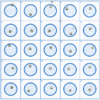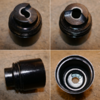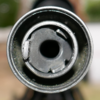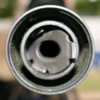Those of you who don't have suppressors may not realise it, but there are point of impact changes which can be experienced when:
1) Shooting suppressed vs unsuppressed
2) Shooting with one suppressor vs another
3) Shooting with a thread adapter vs no adapter
I recently conducted a very rough-and-ready experiment using some of my suppressors. This was on a 25 yard range using one of my R55 Benchmark rifles and one batch of RWS Target Rifle ammunition. The barrel is threaded 1/2" x 28tpi (UNEF) and I have mainly UNEF cans, but some UNF ones too (for 1/2" x 20tpi threads):

I also have some barrel thread adapters (more on that later).
Firstly let me admit that this sort of test, if conducted formally, should be done with a chronograph and the rifle should be in some kind of rest.
Also the rifle should be cleaned, fouled and zeroed between tests so that a set number of unsuppressed rounds are fired on a clean gun and then the tested can is attached.
Also, it needs a better shooter than me (or me on a better day, because I shot badly on the day). But I think the test still has value, even with bad group sizes. It's the position of the groups I am interested in.
Anyway, here's what I did:
1) Using the Ontarget TDS software I printed 10 of the "style 31" targets. You can learn what that software does here: https://ontargetshooting.com/ontarget-tds/
2) Each target has 25 "bulls" or spots and I fired 1 round at each spot.
3) I then scanned the targets at home and imported them into the software to check the group positions.
Here's an example target (I have cropped the extra 5 sighter spots off, and the barcode).
Also not shown is the ruler I scanned with the target, in order to have a 1" reference to calibrate the image in the software:

Yes, I know, that is not great shooting. But it won't nullify the value of this post. Also, the suppressors that were tested all had low round counts. The lowest was 50 and the highest was 150. No chemicals had been sprayed into the suppressors beforehand.
Here are the combinations I tested:
1) No suppressor, no adapter or thread protector
2) Wildcat Predator 12 reflex suppressor with a 150cm reflex tube. That's the big one in the photo
3) ASE Utra Dual Rimfire suppressor (I have 3 of these, this is number 3)
4) ASE Utra Dual Rimfire suppressor as above, but with a UNEF to UNEF thread adapter (yes, same to same, to check for the influence of an adapter on the same rifle and suppressor)
5) Hausken SK156 suppressor
6) Hausken SK156 suppressor as above, but with a UNEF to UNEF thread adapter (yes, same to same, to check for the influence of an adapter on the same rifle and suppressor)
7) Finland Fine Machining SAK suppressor
8) Finland Fine Machining SAK suppressor as above, but with a UNEF to UNEF thread adapter (yes, same to same, to check for the influence of an adapter on the same rifle and suppressor)
9) A-TEC CMM4(6) suppressor (I have 2 of these, this is number 2)
10) A-TEC CMM4(6) suppressor as above, but with a UNEF to UNEF thread adapter (yes, same to same, to check for the influence of an adapter on the same rifle and suppressor)
For reference these are the suppressors, labelled (except for the Wildcat Predator which is not shown). I did not use all of them, but I plan to do more of these tests in the future:

1) Shooting suppressed vs unsuppressed
2) Shooting with one suppressor vs another
3) Shooting with a thread adapter vs no adapter
I recently conducted a very rough-and-ready experiment using some of my suppressors. This was on a 25 yard range using one of my R55 Benchmark rifles and one batch of RWS Target Rifle ammunition. The barrel is threaded 1/2" x 28tpi (UNEF) and I have mainly UNEF cans, but some UNF ones too (for 1/2" x 20tpi threads):

I also have some barrel thread adapters (more on that later).
Firstly let me admit that this sort of test, if conducted formally, should be done with a chronograph and the rifle should be in some kind of rest.
Also the rifle should be cleaned, fouled and zeroed between tests so that a set number of unsuppressed rounds are fired on a clean gun and then the tested can is attached.
Also, it needs a better shooter than me (or me on a better day, because I shot badly on the day). But I think the test still has value, even with bad group sizes. It's the position of the groups I am interested in.
Anyway, here's what I did:
1) Using the Ontarget TDS software I printed 10 of the "style 31" targets. You can learn what that software does here: https://ontargetshooting.com/ontarget-tds/
2) Each target has 25 "bulls" or spots and I fired 1 round at each spot.
3) I then scanned the targets at home and imported them into the software to check the group positions.
Here's an example target (I have cropped the extra 5 sighter spots off, and the barcode).
Also not shown is the ruler I scanned with the target, in order to have a 1" reference to calibrate the image in the software:

Yes, I know, that is not great shooting. But it won't nullify the value of this post. Also, the suppressors that were tested all had low round counts. The lowest was 50 and the highest was 150. No chemicals had been sprayed into the suppressors beforehand.
Here are the combinations I tested:
1) No suppressor, no adapter or thread protector
2) Wildcat Predator 12 reflex suppressor with a 150cm reflex tube. That's the big one in the photo
3) ASE Utra Dual Rimfire suppressor (I have 3 of these, this is number 3)
4) ASE Utra Dual Rimfire suppressor as above, but with a UNEF to UNEF thread adapter (yes, same to same, to check for the influence of an adapter on the same rifle and suppressor)
5) Hausken SK156 suppressor
6) Hausken SK156 suppressor as above, but with a UNEF to UNEF thread adapter (yes, same to same, to check for the influence of an adapter on the same rifle and suppressor)
7) Finland Fine Machining SAK suppressor
8) Finland Fine Machining SAK suppressor as above, but with a UNEF to UNEF thread adapter (yes, same to same, to check for the influence of an adapter on the same rifle and suppressor)
9) A-TEC CMM4(6) suppressor (I have 2 of these, this is number 2)
10) A-TEC CMM4(6) suppressor as above, but with a UNEF to UNEF thread adapter (yes, same to same, to check for the influence of an adapter on the same rifle and suppressor)
For reference these are the suppressors, labelled (except for the Wildcat Predator which is not shown). I did not use all of them, but I plan to do more of these tests in the future:







































